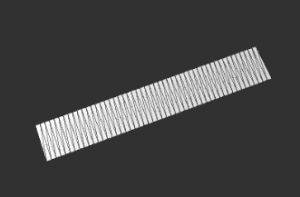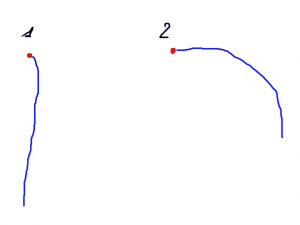02-12-2020, 12:24 PM
Hello there,
I've been working for a while with the ObiCloth plugin, trying to get a bit deeper in it. My goal is to simulate a very long (about a hundred meters) sheet of metal (copper actually). The sheet is about 20cm-wide, and I want to implement some kind of rigidity to it.
My first goal as been to remove the flexibility in the middle of the band. The solution I've found was to remove all the particles in the middle : I'm generating a long mesh with particles on the sides, and none on the inside. Here's an image of my generated bands :

This was made for two reasons : removing the possibility to bend in the length of the band, and considerably reduce the number of particles involved in the simulation (because the bands I use are much much longer).
I've then tweaked a bit the solver settings (increasing the distance constraints iterations to reduce the stretching, and disabling most of the other constraints to lighten the calculation charge). I got to the point where I can use the band almost like I want, attaching and detaching it dynamically with an unwinding - winding setup. I want to optimize it as much as i can : the problem i face today is the bending of the band.
I want it to stay as straight as it can, as if i was holding a sheet of paper by the side :

On this example, the band of the left bends a lot. It's the current way the simulation works. I'd like it to act more like the example on the right.
So this si mainly a bending problem. I also have question about the way the forces are calculated, because I'd like to simulate a traction sensor, and i need to get the force applied by the band on a cylinder for example.
Thank you for reading this if you have any info I'm really interested.
I've been working for a while with the ObiCloth plugin, trying to get a bit deeper in it. My goal is to simulate a very long (about a hundred meters) sheet of metal (copper actually). The sheet is about 20cm-wide, and I want to implement some kind of rigidity to it.
My first goal as been to remove the flexibility in the middle of the band. The solution I've found was to remove all the particles in the middle : I'm generating a long mesh with particles on the sides, and none on the inside. Here's an image of my generated bands :
This was made for two reasons : removing the possibility to bend in the length of the band, and considerably reduce the number of particles involved in the simulation (because the bands I use are much much longer).
I've then tweaked a bit the solver settings (increasing the distance constraints iterations to reduce the stretching, and disabling most of the other constraints to lighten the calculation charge). I got to the point where I can use the band almost like I want, attaching and detaching it dynamically with an unwinding - winding setup. I want to optimize it as much as i can : the problem i face today is the bending of the band.
I want it to stay as straight as it can, as if i was holding a sheet of paper by the side :
On this example, the band of the left bends a lot. It's the current way the simulation works. I'd like it to act more like the example on the right.
So this si mainly a bending problem. I also have question about the way the forces are calculated, because I'd like to simulate a traction sensor, and i need to get the force applied by the band on a cylinder for example.
Thank you for reading this if you have any info I'm really interested.




